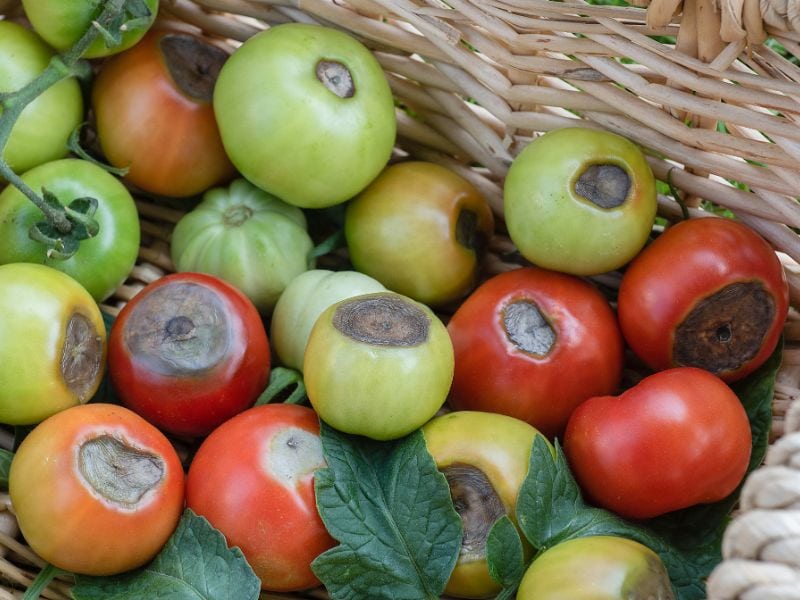Table of Contents
What is Blossom End Rot and How Can You Prevent It?

Blossom end rot is a common problem in tomatoes, peppers, and other vegetables. It is caused by a lack of calcium in the soil, which can be caused by inconsistent watering or soil that is too acidic. The symptoms of blossom end rot are dark, sunken spots on the bottom of the fruit.
Fortunately, there are ways to prevent blossom end rot. The most important thing is to make sure your soil has enough calcium and that it stays at the right moisture levels through the growing season. You can do this by adding lime to the soil or using a fertilizer that contains calcium. You should also make sure to water your plants consistently, as inconsistent watering can lead to calcium deficiencies. Finally, make sure your soil is not too acidic. If it is, you can add some wood ash or dolomite lime to help balance the pH.
By following these steps, you can help prevent blossom end rot and ensure your plants get the calcium they need.
How to Identify and Treat Blossom End Rot in Tomatoes
Blossom end rot is a common problem for tomato growers. It’s a disorder caused by a lack of calcium in the fruit, and it can be identified by a dark, leathery patch on the bottom of the tomato.
If you’re seeing blossom end rot on your tomatoes, don’t worry – it’s easy to treat. Here’s what you need to do:
1. Test your soil. The first step is to test your soil to make sure it has enough calcium. If it doesn’t, you’ll need to add some.
2. Add calcium. If your soil is lacking calcium, you can add it in the form of lime or gypsum. Follow the instructions on the package for how much to add.
3. Water regularly. Make sure you’re watering your tomatoes regularly and evenly. This will help ensure that the calcium is getting to the roots of the plant.
4. Mulch. Mulching your tomatoes can help keep the soil moist and prevent blossom end rot from occurring.
5. Prune. Pruning your tomatoes can help reduce the amount of fruit on the plant, which can help reduce the risk of blossom end rot.
Since calcium is the issue, you might also consider grinding up egg shells and mixing them into your garden soil. By following these steps, you can help prevent blossom end rot from occurring in your tomatoes. If you do find blossom end rot on your tomatoes, don’t worry – it’s easy to treat. Just follow the steps above and you’ll be on your way to healthy, delicious tomatoes!
Understanding the Causes of Blossom End Rot in Tomatoes
Have you ever noticed dark, leathery patches on the bottom of your tomatoes? If so, you may have encountered blossom end rot. This common tomato problem is caused by a lack of calcium in the fruit, and it can be a real bummer for gardeners. Let’s take a look at what causes blossom end rot and how to prevent it.
First, let’s talk about what blossom end rot is. It’s a disorder that affects the bottom of the tomato, causing it to become discolored and leathery. The affected area may start out as a light tan color and then darken to a deep brown or black. The rot can spread to the entire bottom of the tomato, making it inedible.
So, what causes blossom end rot? The main culprit is a lack of calcium in the fruit. Calcium is essential for healthy tomato growth, and when it’s lacking, the fruit can’t develop properly. This can be caused by a number of factors, including inconsistent watering, high temperatures, and soil that’s too acidic or too alkaline.

Fortunately, there are a few steps you can take to prevent blossom end rot. The most important thing is to make sure your tomatoes get enough water. Water your plants deeply and consistently, and make sure the soil is evenly moist. You should also make sure your soil is not too acidic or too alkaline. A soil test kit can help you determine the pH level of your soil. Finally, mulching your plants can help keep the soil temperature consistent and prevent rapid fluctuations.
Blossom end rot can be a frustrating problem, but with a little knowledge and effort, you can prevent it from happening. Make sure your tomatoes get enough water, keep the soil pH balanced, and mulch your plants to keep the soil temperature consistent. With these steps, you can enjoy a bumper crop of delicious tomatoes!
Tips for Creating an Environment Conducive to Preventing Blossom End Rot in Tomatoes
1. Plant tomatoes in well-draining soil. Make sure the soil is not too compacted, as this can lead to poor drainage and an increased risk of blossom end rot.
2. Water your tomatoes regularly and evenly. Avoid over-watering, as this can lead to blossom end rot. Aim to keep the soil moist, but not soggy.
3. Fertilize your tomatoes with a balanced fertilizer. This will help ensure that your tomatoes have access to the nutrients they need to grow and thrive.
4. Mulch your tomatoes to help retain moisture and reduce the risk of blossom end rot.
5. Avoid stressing your tomatoes by providing them with adequate space and sunlight.
6. Monitor your tomatoes for signs of blossom end rot, such as dark, sunken spots on the bottom of the fruit. If you notice any signs of blossom end rot, remove the affected fruit and take steps to improve the environment for your tomatoes.



